Overview of Organ Systems/Anatomy
1/44
There's no tags or description
Looks like no tags are added yet.
Name | Mastery | Learn | Test | Matching | Spaced |
|---|
No study sessions yet.
45 Terms
remember, how do you study anatomy?
common sense
learn how things connect
learn what the names of the structures are AND what they mean
we are studying God’s creation.
what are the learning objectives (they literally tell you the answers)
Define the components of the lymphatic system (lymphatic vessels, plexus, lymph, lymph nodes and lymphoid organs.
Locate the general distribution of lymph nodes.
Discuss the basic etiology (causes of disease) of clinical cases associated to the lymphatic system (edema, lymphadenopathy, lymphangioma, lymphoma, lymph flow and metastasis).
Define the components of the lymphatic system (lymphatic vessels, plexus, lymph, lymph nodes and lymphoid organs).
Recognize the subdivisions of the autonomic division of the nervous system (ANS).
Identify the components of both divisions of ANS and the basis for these distinctions.
Differentiate the location of the cell body and tract of axon of the neurons in the sympathetic and parasympathetic system.
Describe the effects of stimulating sympathetic or parasympathetic fibers in several organs (eyes, skin, heart, lungs and digestive tract).
(learning objectives)
Define the components of the lymphatic system (lymphatic vessels, plexus, lymph, lymph nodes and lymphoid organs.
Lymphatic Vessels: A network of tubes that collect and transport excess tissue fluid (lymph) back to the bloodstream. They begin as blind-ended capillaries and converge into larger vessels (lymphatics, trunks, and ducts).
Lymphatic Plexus: A web-like network of tiny lymphatic capillaries interwoven in the tissue spaces. This is where lymph formation begins.
Lymph: The clear, watery fluid found in lymphatic vessels. It is essentially tissue fluid (plasma that has leaked from capillaries) that has entered the lymphatic system. It also contains white blood cells (especially lymphocytes) and sometimes cell debris or pathogens.
Lymph Nodes: Small, bean-shaped organs scattered along the pathways of lymphatic vessels. They are filters: they contain immune cells (lymphocytes and macrophages) that trap and destroy pathogens and foreign particles in the lymph before it returns to the blood.
Lymphoid Organs: Organs that produce and store lymphocytes and other immune cells. They are classified as:
Primary: Where lymphocytes are produced and mature.
Red Bone Marrow: Produces all blood cells, including lymphocytes.
Thymus: Where T-lymphocytes mature.
Secondary: Where lymphocytes encounter pathogens and mount an immune response.
Spleen: Filters blood, removes old RBCs, and fights blood-borne pathogens.
Lymph Nodes: Filter lymph.
Tonsils & MALT (Mucosa-Associated Lymphoid Tissue): Protect mucosal surfaces (e.g., in the digestive and respiratory tracts).
(learning objectives)
Locate the general distribution of lymph nodes:
Lymph nodes are clustered in key regions that drain specific body areas. Major groups include:
Cervical: Neck (drain head and neck).
Axillary: Armpit (drain upper limb, breast, and superficial thorax).
Tracheobronchial & Mediastinal: Thoracic cavity (drain lungs and heart).
Mesenteric: Abdomen (drain the digestive tract).
Para-aortic: Abdomen (drain deep abdominal structures).
Inguinal: Groin (drain lower limb, external genitalia, and inferior abdominal wall).
Popliteal: Behind the knee (drain the leg).
(learning objectives)
Discuss the basic etiology of clinical cases:
Edema: Swelling caused by excess fluid in the tissues. Lymphatic cause: Obstruction or failure of lymphatic vessels to drain tissue fluid (lymphedema).
Lymphadenopathy: Swollen or enlarged lymph nodes. Cause: Often indicates an immune response to infection (e.g., strep throat), cancer (e.g., lymphoma, metastasis), or inflammatory disease.
Lymphangioma: A benign tumor (malformation) of the lymphatic vessels, present from birth.
Lymphoma: A malignant cancer that originates in the lymphocytes within lymphoid tissues (e.g., Hodgkin's vs. Non-Hodgkin's lymphoma).
Lymph Flow & Metastasis: Cancer cells can break away from a primary tumor, enter lymphatic vessels, and be carried to lymph nodes where they establish secondary tumors. This is a common pathway for cancer spread.
(Part 2: The Autonomic Nervous System (ANS)
Recognize the subdivisions of the ANS:
The ANS is the visceral motor division of the PNS. It has two primary, opposing subdivisions:
Sympathetic Nervous System (SNS): "Fight-or-Flight"
Parasympathetic Nervous System (PNS): "Rest-and-Digest"
Identify the components and basis for distinctions:
The key anatomical distinctions are based on the origin of the nerves and the location of their ganglia.
Feature | Sympathetic Division | Parasympathetic Division |
|---|---|---|
Origin (CNS) | Thoracolumbar (T1-L2 spinal cord) | Craniosacral (Brainstem & S2-S4 spinal cord) |
Ganglion Location | Close to CNS (Paravertebral chain & Prevertebral ganglia) | Close to or within Target Organ (Terminal ganglia) |
Length of Fibers | Short preganglionic, Long postganglionic | Long preganglionic, Short postganglionic |
Neurotransmitter | Norepinephrine (mostly) | Acetylcholine (ACh) |
Differentiate the location of the cell body and tract of axon:
Sympathetic:
Preganglionic Neuron: Cell body in the lateral gray horn of spinal cord levels T1-L2. Its axon is short, exits the cord, and synapses in a ganglion.
Postganglionic Neuron: Cell body in a sympathetic ganglion. Its axon is long and travels to the target organ.
Parasympathetic:
Preganglionic Neuron: Cell body in the brainstem nucleus or the sacral spinal cord (S2-S4). Its axon is very long and travels close to the target organ.
Postganglionic Neuron: Cell body in a terminal ganglion near or within the wall of the target organ. Its axon is very short.
Describe the effects of stimulation on several organs:
Organ | Sympathetic Stimulation ("Fight-or-Flight") | Parasympathetic Stimulation ("Rest-and-Digest") |
|---|---|---|
Eye (Pupil) | Dilation (mydriasis) - to allow more light in | Constriction (miosis) - for close vision |
Skin (Sweat Glands) | Stimulates sweating | No effect (not innervated by PNS) |
Heart | Increases heart rate and force of contraction | Decreases heart rate |
Lungs (Bronchi) | Dilation - to increase air flow | Constriction - not a primary need during rest |
Digestive Tract | Decreases motility and gland secretion | Increases motility and gland secretion |
Salivary Glands | Thick, mucous saliva | Watery, profuse saliva |
AUTONOMIC NERVOUS SYSTEM
what is the autonomic nervous system?
what is homeostasis?
Autonomic Nervous System (ANS) is a crucial part of your nervous system that operates largely unconsciously to regulate your body's essential internal functions and maintain internal stability (a process called homeostasis).
what are all the things autonomic nervous system controls?
The ANS constantly monitors and controls your:
Heart rate and blood pressure
Breathing rate (respiratory rate)
Body temperature
Digestion and salivation
Metabolic processes
Urination and defecation
Sexual response
Pupillary size (dilation and constriction)
Sweating (perspiration)
To achieve this, it primarily innervates smooth muscle (in blood vessels, gut), cardiac muscle (the heart), and glands (salivary, sweat).
what are the two main divisions of the autonomic nervous system?
sympathetic and parasympathetic
parasympathetic nervous system
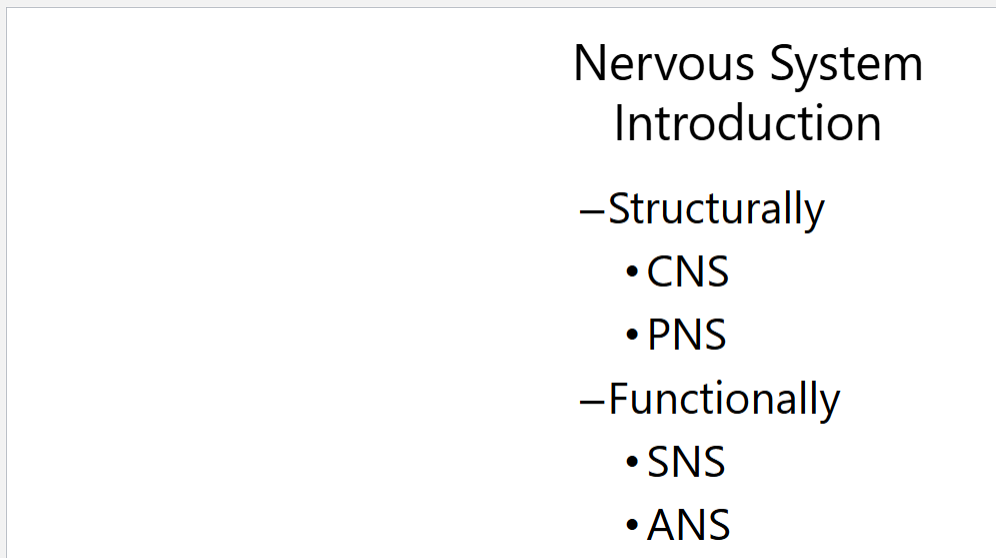
what are the two main ways to classify the nervous system?
what is the Structural Classification
what does the CNS do?
what are the components of the CNS?
what does the PNS do?
what are the components of the PNS?
what are the two types of nerves?
what are ganglia?
what is the second functional classification?
what is the SNS?
what is the ANS?
what are the divisions of the ANS?
The Two Ways to Classify the Nervous System: Structure and by Function.
1. Structural Classification (Anatomy - "The Hardware")
This is based on the physical structures of the nervous system.
Central Nervous System (CNS)
Function: The command center. It integrates and processes all information received from the PNS and sends out instructions.
Components:
Brain: Located in the skull. Responsible for higher functions (thought, memory, emotion), interpreting sensory data, and initiating voluntary movement.
Spinal Cord: Located within the vertebral canal. Acts as a major communication pathway between the brain and the body. Also handles reflex arcs.
Peripheral Nervous System (PNS)
Function: The communication network. It connects the CNS to the rest of the body (limbs, organs, skin). It consists of all the nerves and ganglia (clusters of neuron cell bodies) outside the CNS.
Components:
Nerves: Bundles of axons that carry signals. Cranial nerves emerge from the brain, and spinal nerves emerge from the spinal cord.
Ganglia: Small clusters of neuron cell bodies found along nerves.
2. Functional Classification (Physiology - "The Software")
This is based on the type of work the nervous system does. This classification applies to the PNS.
Somatic Nervous System (SNS)
Function: Controls voluntary movements and conveys sensory information.
"Voluntary Control": You consciously decide to use these nerves to, for example, lift your hand or kick a ball. They carry motor commands from the CNS to skeletal muscles.
Sensory Input: Also carries conscious sensory information from the skin, joints, and muscles (e.g., touch, temperature, pain, proprioception) to the CNS.
Autonomic Nervous System (ANS)
Function: Controls involuntary processes. It regulates the internal environment by controlling glands, cardiac muscle, and smooth muscle (found in walls of hollow organs and blood vessels). It's the "autopilot" system.
Subdivisions: The ANS has three parts that often work in opposition to maintain balance (homeostasis):
Sympathetic Nervous System: "Fight-or-Flight." Prepares the body for intense activity or stress (e.g., increases heart rate, dilates pupils).
Parasympathetic Nervous System: "Rest-and-Digest." Promotes relaxation and conservation of energy (e.g., stimulates digestion, slows heart rate).
Enteric Nervous System: The "brain in the gut." Independently controls the gastrointestinal system.
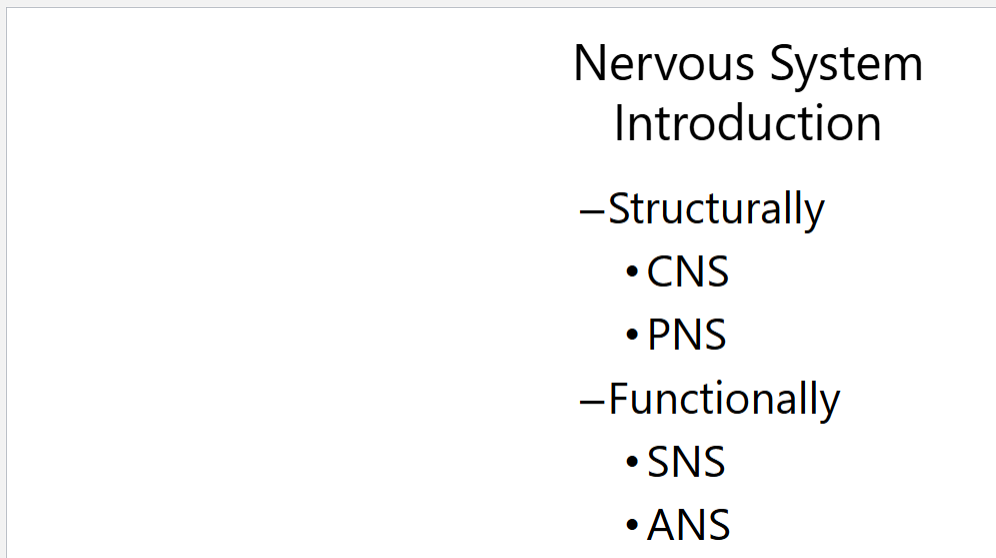
(sympathetic nervous system)
1. Sympathetic Nervous System (SNS) - The "Fight-or-Flight" System
Function: Prepares the body for emergency, stress, or intense activity. It's the accelerator.
What it does:
↑ Heart rate and force of contraction
↑ Blood pressure
Dilates airways (bronchodilation) for more oxygen
Dilates pupils to improve vision
Inhibits digestion and salivation (shunts blood away to muscles)
Stimulates release of glucose from the liver for energy
Stimulates sweating
Key Neurotransmitter: Norepinephrine (Noradrenaline)
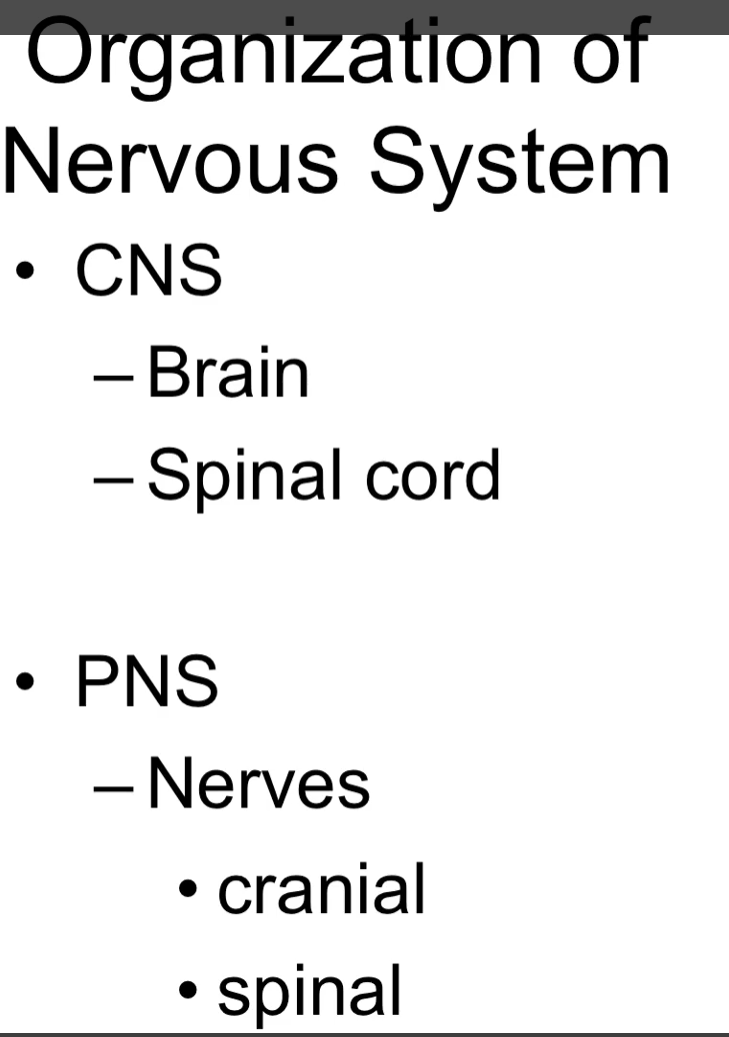
are the cranial nerves located in the PNS or CNS?
are the spinal nerves located in the PNS or CNS?
are the peripheral nerves located in the CNS or PNS?
pay attention to the picture
cranial nerves: PNS
spinal nerves: PNS
peripheral nerves: PNS
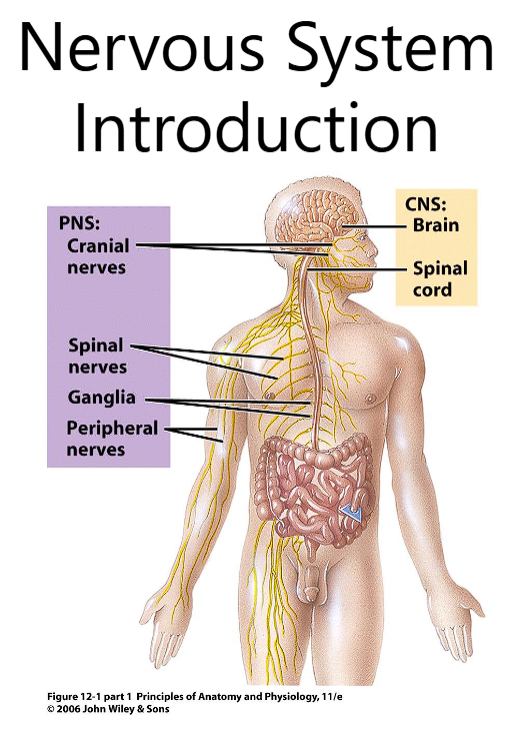
The Building Blocks: Nervous Tissue
The entire nervous system—both the CNS and the PNS—is constructed from just two main types of cells:
Neurons
Neuroglia (or Glial Cells)
These cells are organized into nervous tissue.
1. Neurons (The "Wiring" and "Processors")
Function: Neurons are the functional units of the nervous system. They are responsible for generating and conducting nerve impulses (electrochemical signals). They are the cells that handle communication, information processing, and control.
Key Properties:
Excitability (Irritability): Ability to respond to a stimulus and convert it into an electrical impulse.
Conductivity: Ability to transmit the electrical impulse to other neurons, muscles, or glands.
Basic Structure: A neuron has three main parts:
Cell Body (Soma): Contains the nucleus and maintains the cell.
Dendrites: Short, branching extensions that receive signals from other neurons.
Axon: A long, thin fiber that sends signals away from the cell body to other cells.
2. Neuroglia (The "Support Staff")
Function: Neuroglia, or glial cells, are the supporting cells of the nervous system. They do not conduct nerve impulses themselves, but they are essential for maintaining a healthy environment for the neurons to function. They are far more numerous than neurons.
Key Roles: They provide support, insulation, nutrients, and protection for neurons. They also clean up waste and regulate the chemical environment around neurons.
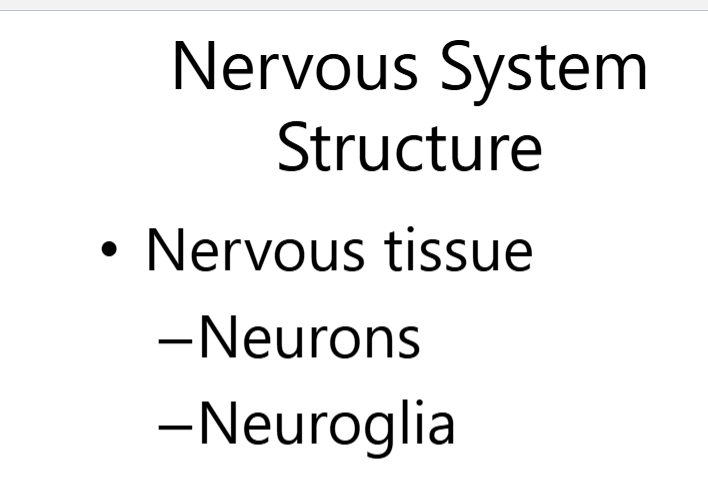
(Types of Neuroglia in the CNS vs. PNS)
Neuroglia in the CNS (Brain & Spinal Cord): astrocytes, oligodendrocytes, Microglia, Ependymal Cells
neuroglia in the PNS: Schwann Cells, Satellite Cells
Neuroglia in the CNS (Brain & Spinal Cord):
Cell Type | Primary Function |
|---|---|
Astrocytes | Anchor neurons to blood supply; regulate nutrient & ion balance; form the blood-brain barrier. |
Oligodendrocytes | Wrap their plasma membranes around axons to create the myelin sheath, which insulates axons and speeds up signal transmission. |
Microglia | The immune cells of the CNS; they phagocytize (eat) pathogens and cellular debris. |
Ependymal Cells | Line the fluid-filled ventricles of the brain and central canal of the spinal cord; help produce and circulate cerebrospinal fluid (CSF). |
Neuroglia in the PNS (Nerves):
Cell Type | Primary Function |
|---|---|
Schwann Cells | The PNS equivalent of oligodendrocytes. They wrap around axons to form the myelin sheath. They are also crucial for helping damaged nerves regenerate. |
Satellite Cells | The PNS equivalent of astrocytes. They surround and support neuron cell bodies in ganglia (clusters of neurons outside the CNS). |
summary of neurons and glia
Summary in a Nutshell:
Neurons are the signal-conducting cells.
Neuroglia are the support cells that make neural signaling efficient and possible.
Together, they form nervous tissue, which is organized into the structures of the CNS (brain, spinal cord) and PNS (nerves, ganglia).
(neurons)
multipolar (motor commands)
why are multipolar neurons called multipolar?
what do multipolar neurons innervate?
what is the role of motor neurons in the CNS and PNS?
pseudounipolar (sensory neurons)
pseudounipolar (sensory neurons) carry information from where to what?
pseudounipolar (sensory neurons) are located where?
what is the function of a ganglia?
what are dorsal root ganglia?
what are autonomic ganglia?
1. Multipolar Neuron (many poles or processes): A neuron with one axon and multiple dendrites extending from its cell body
Significance: This is the most common neuron type in the central nervous system (CNS)
motor neurons are the primary neuron type for motor commands.
Function: They are primarily motor neurons (innervating muscles and glands) and interneurons (forming connections between other neurons within the CNS).
Location is both CNS and PNS:
CNS: All neurons in the brain and spinal cord that are not purely sensory are multipolar.
PNS: Motor neurons that control skeletal muscle, smooth muscle, and glands are multipolar.
Simple Diagram: Imagine a starfish with one long arm (the axon) and many shorter, branched arms (the dendrites).
Pseudounipolar Neuron (“fasely one poled”) : A neuron where the cell body has a single, short process that immediately splits into two branches like a "T."
Significance: This structure is a hallmark of sensory neurons that carry information from the body to the CNS.
Function: One branch (peripheral process) carries sensory information from the body (e.g., touch, pain, temperature). The other branch (central process) carries that same information into the spinal cord.
Location: Exclusively in the PNS. Their cell bodies are found in the dorsal root ganglia (for body sensation) and sensory ganglia of cranial nerves (for head sensation).
Key Point: The cell body is off to the side of the main signal pathway and does not play a role in receiving information; it just provides metabolic support.
Ganglia (Singular: Ganglion)
Definition: A collection of neuron cell bodies located outside the central nervous system.
Significance: They are like relay stations or outposts in the peripheral nervous system.
Function: They house the cell bodies of sensory and autonomic neurons.
Location & Types:
Dorsal Root Ganglia: Located along the dorsal roots of spinal nerves. Contain cell bodies of sensory (pseudounipolar) neurons.
Autonomic Ganglia: Located in the PNS as part of the autonomic motor pathway. Contain cell bodies of motor (multipolar) neurons that innervate involuntary targets like cardiac muscle, smooth muscle, and glands.
Examples: Sympathetic chain ganglia, celiac ganglion.
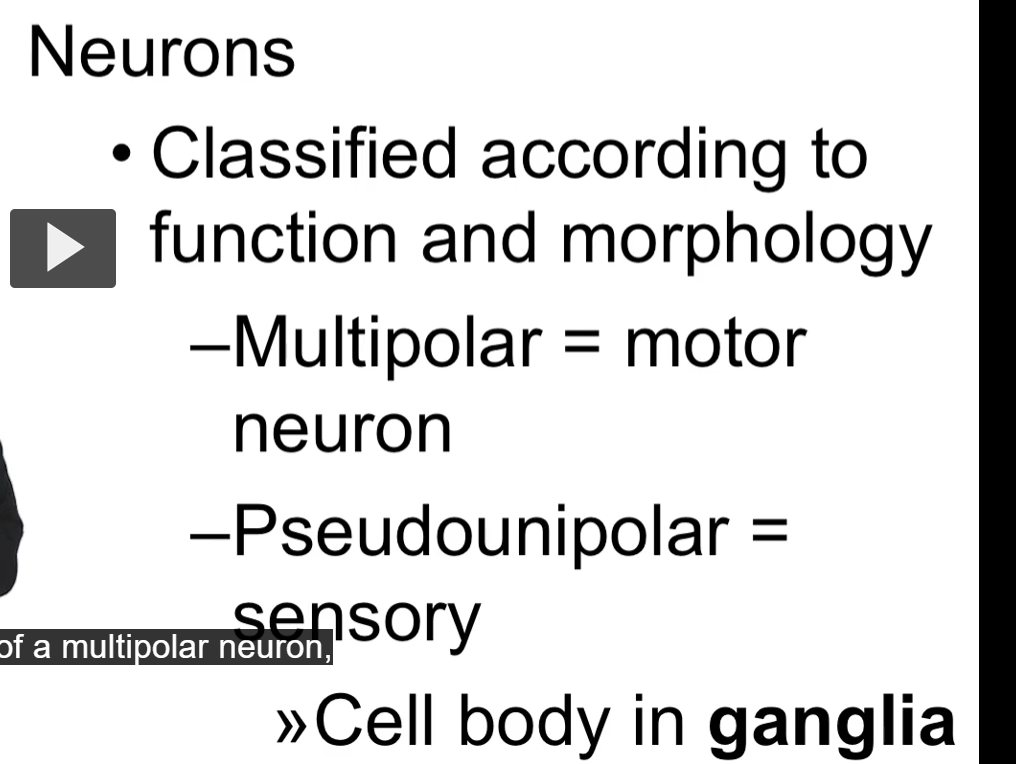
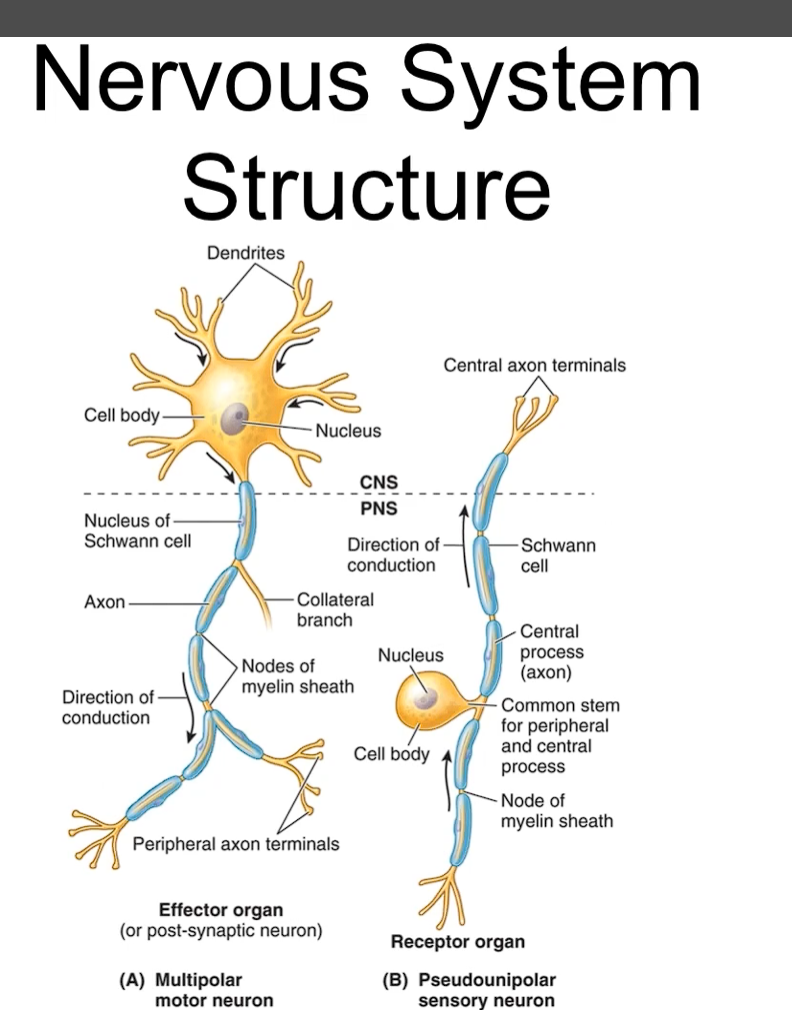
what is the one job of pseudounipolar cells?
why don’t pseudounipolar cells have dendrites?
Pseudounipolar neurons have one job: to transmit sensory information (like touch, pain, temperature) from the body's periphery to the spinal cord as quickly and efficiently as possible.
The short answer is: They do have a dendrite, but it's structurally fused to their axon, forming a single, continuous process.
neuroglia (what are the three functions)?
the other type of cell in the nervous system
MORE NUMEROUS THAN NEURONS, yet SMALLER in SIZE.
neurons are supposed to 1) support, 2) insulate and 3) nourish the neurons in the CNS.
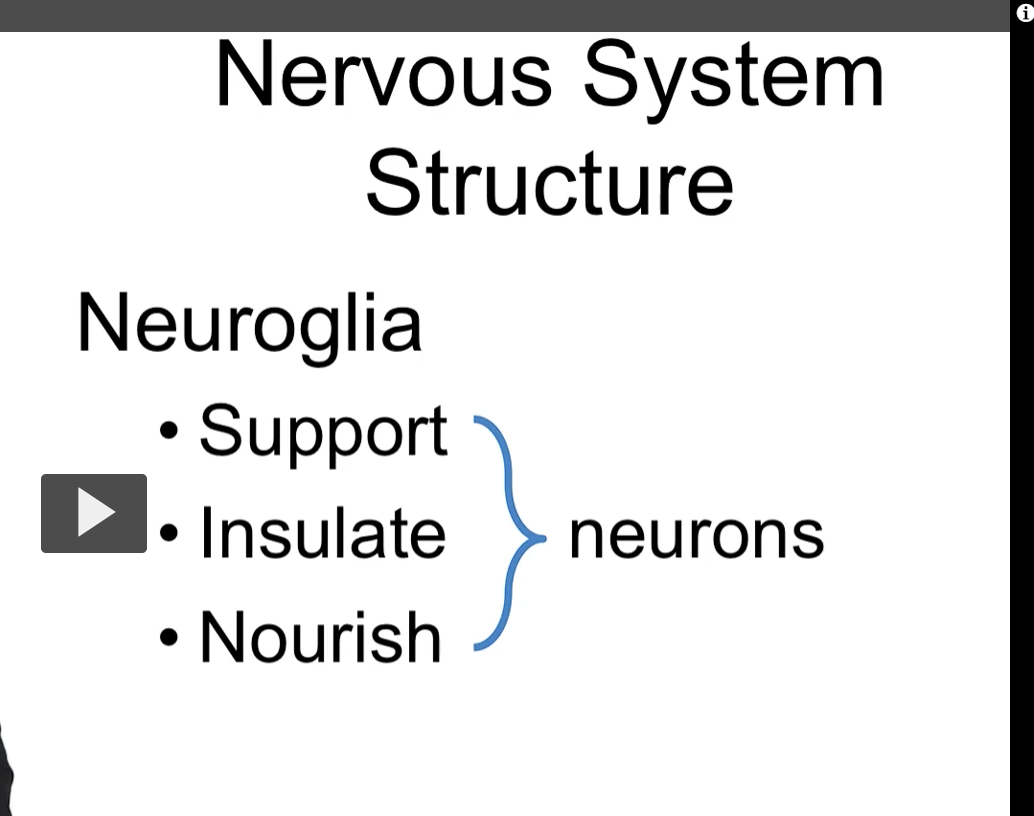
neurons communicate with each other through the synapse.
the terminal of the axon of one neuron communicates with the dendrites of the axon of the second neuron.
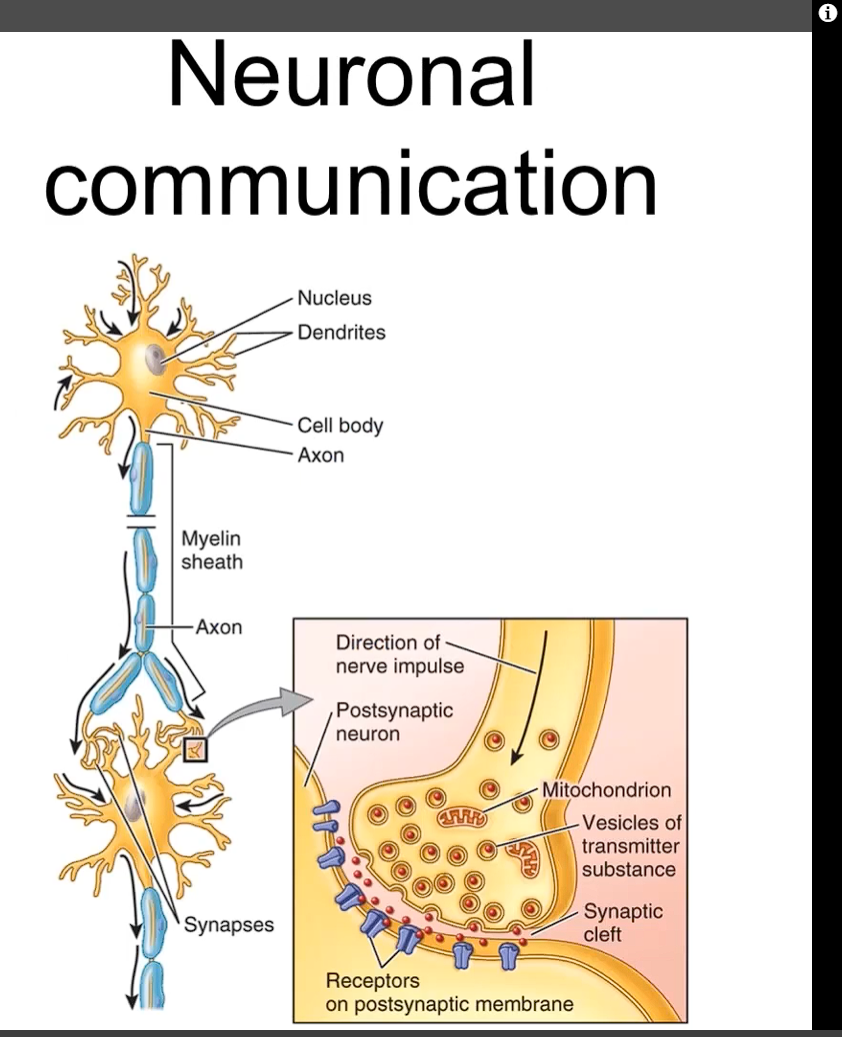
how many total pairs of spinal nerves (nerves found in the spine)?
how many sets of cervical nerves?
how many sets of thoracic nerves
how many sets of lumbar and sacrum ne
31 pairs of spinal nerves
spinal nerves are classified according to where they exit the spinal cord
8 sets of cervical nerves
12 sets of thoracic nerves
5 sets of lumbar nerves
5 sets of sacrum nerves
all of them are exiting of both sides of the spinal cord in the region called the intervetebral foramen
the spinal cord has two enlargements, the cervical and the lumbar enlargements, these enlargements are due to the number of increased neurons that are involved in the limbs innervation.
Summary & Confirmation of Your Points:
31 Pairs: Correct. There are 31 pairs of spinal nerves: 8 cervical, 12 thoracic, 5 lumbar, 5 sacral, and 1 coccygeal.
Classification by Exit Point: Correct. They are named for the vertebral region they exit from (e.g., the 4th thoracic nerve exits at the T4 vertebra).
Regional Distribution: Your numbers are exactly right.
Exit Location: Perfect. They exit the spinal cord through the intervertebral foramen (the opening between adjacent vertebrae).
Enlargements: Absolutely correct. The cervical enlargement (C4-T1) supplies nerves to the upper limbs (brachial plexus), and the lumbar enlargement (L1-S3) supplies nerves to the lower limbs (lumbosacral plexus). The increased neuron count is for the complex motor control and sensory input of the limbs.
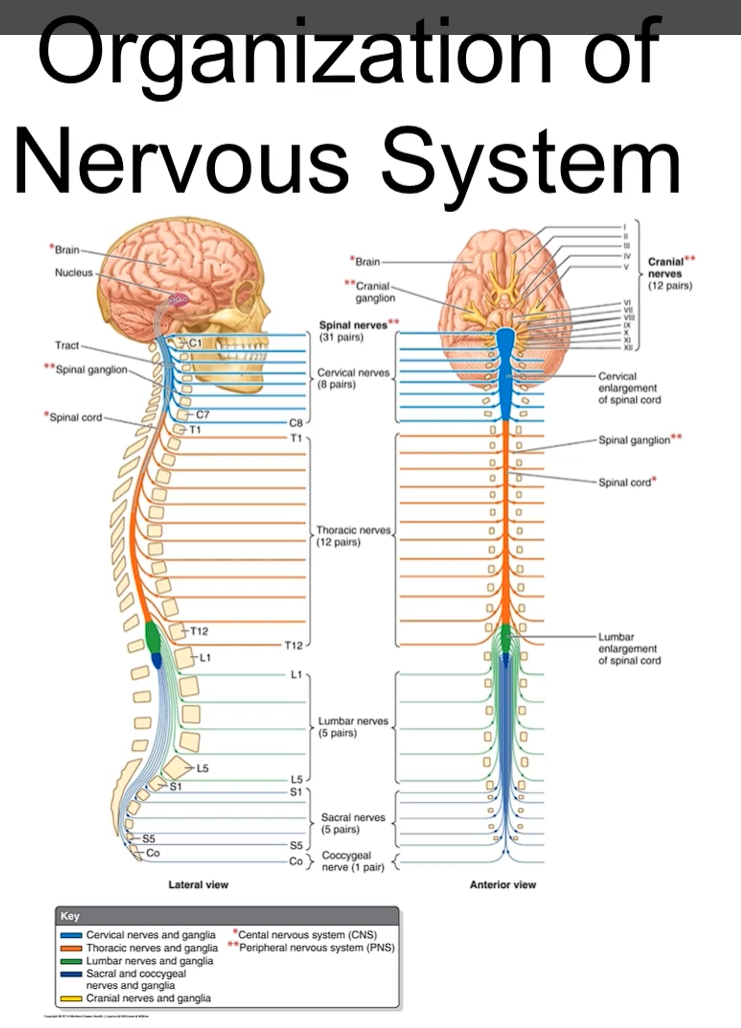
spinal nerve information continued
Key Additions & Clinical Context:
Here is some additional information that builds on your perfect foundation:
1. The "C8" Quirk:
There are 8 cervical spinal nerves but only 7 cervical vertebrae.
The C1-C7 nerves exit above their corresponding vertebra (e.g., C4 nerve exits above the C4 vertebra).
The C8 nerve exits below the C7 vertebra and above the T1 vertebra.
From T1 down, all other nerves exit below their corresponding vertebra.
2. The Cauda Equina ("Horse's Tail"):
The spinal cord itself is shorter than the vertebral column. It typically ends at the level of the L1 or L2 vertebra in adults in a structure called the conus medullaris.
The lumbar and sacral nerve roots (from the lumbar enlargement) must travel down through the vertebral canal before exiting their respective foramina.
This collection of long nerve roots streaming down looks like a horse's tail, hence its name, the cauda equina. This is a common site for pathology like disc herniations.
3. Mixed Nerves:
Each spinal nerve is a mixed nerve, meaning it contains both:
Sensory (Afferent) Fibers: Carry information from the body (e.g., touch, pain, temperature) to the spinal cord.
Motor (Efferent) Fibers: Carry commands from the spinal cord to the muscles and glands.
Just after exiting the foramen, each spinal nerve splits into two main branches:
Dorsal Ramus: A smaller branch that innervates the skin and deep muscles of the back.
Ventral Ramus: A larger branch that innervates the skin and muscles of the front and sides of the body, and all the limbs. The ventral rami form the great nerve networks called plexuses (e.g., brachial plexus for the arm, lumbosacral plexus for the leg).
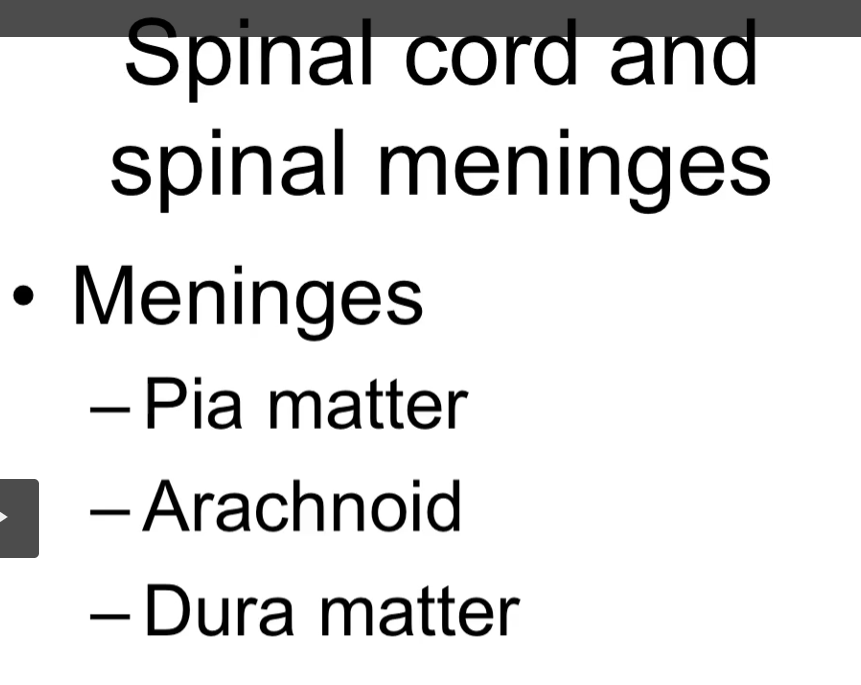
Meninges (membranes)
what are the three functions of the meninges?
what is the superficial layer of the minenges?
Meninges: third structure that protects the nervous system structure (in addition to the skull and spinal cord)
The Spinal Meninges: Protective Layers
The meninges (singular: meninx) are three connective tissue membranes that envelop the brain and spinal cord. Their primary functions are to:
Protect the delicate neural tissue. (dura matter)
Anchor the spinal cord within the vertebral canal. (pia matter)
Contain the cerebrospinal fluid (CSF) (arachnoid matter).
They are arranged in order from superficial to deepest.
1. Dura Mater ("Tough Mother")
Location: The outermost layer. It is a thick, tough, fibrous, and durable membrane that provides the strongest protection.
Key Feature: It forms a single, tubular dural sac that encloses the spinal cord and cauda equina within the vertebral canal.
the dural sac is separated from the walls of the vertebral canal by the epidural space, which is filled with fat and a network of veins (epidural venous plexus). This is the space where an epidural anesthetic is administered.
Arachnoid Mater ("Spider-Web Like Mother")
Location: The middle layer. It is a loose, web-like, avascular membrane that lies between the pia and dura maters.
Key Feature: The space between the arachnoid mater and the pia mater is called the subarachnoid space. This space is:
Filled with cerebrospinal fluid (CSF), which cushions the spinal cord.
Where large blood vessels run.
The site for medical procedures like spinal taps (lumbar punctures), where a needle is inserted to collect CSF.
3. Pia Mater (deepest) ("Tender Mother")
Location: The innermost layer.
It is a very thin, delicate, and highly vascularized membrane that clings intimately to every surface of the spinal cord and brain, following all its contours.
Key Specialization: The denticulate ligaments are lateral, tooth-like extensions of the pia mater that anchor the spinal cord to the dura mater, providing lateral stability and preventing excessive movement.
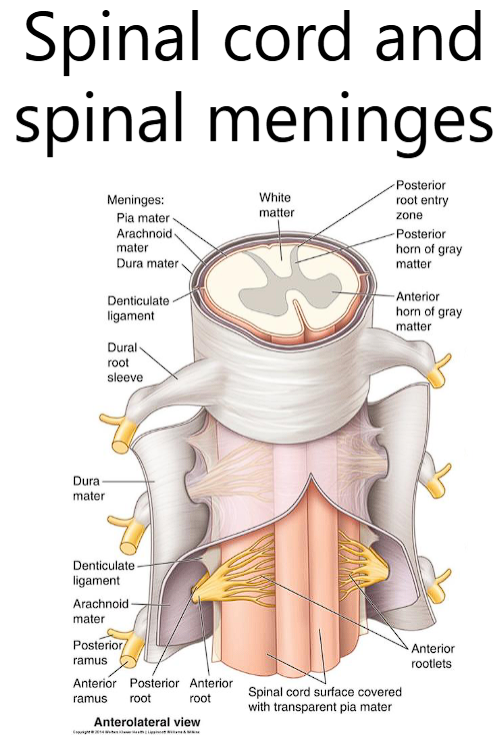
you can see the different layers of images that are covering the spinal cord in this case.
dura matter is external
deep to the dura matter is the aranoid matter, deep to the aranoid matter is the pia matter.
the pia matter is made of _____ cells that are going to cover the spinal cord and the three meninges are also covering parts of the spinal nerves that are existing the spinal cord/central nervous system.
Composition of the Pia Mater:
The pia mater is a thin, transparent layer composed of flattened (squamous) cells derived from the mesoderm, known as mesothelial cells.
These cells are impermeable and form a barrier. This layer is highly vascularized, meaning it is rich in tiny blood vessels that supply oxygen and nutrients to the underlying neural tissue of the spinal cord.
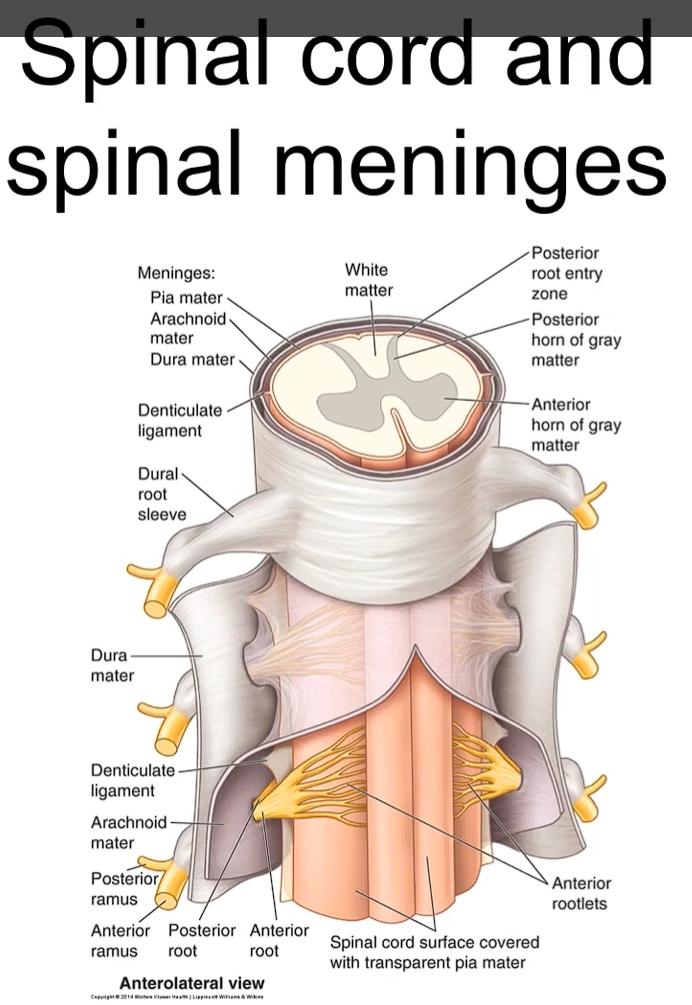
(spinal nerves)
spinal nerves arise from the spinal cord
spinal nerves are formed by the neurons that are inside the spinal cord
the neurons in the spinal cord are located in a region specifically called the gray matter.
the grey matter is H or butterfly shaped.
the axons of these neurons are going to emerge or exit the spinal cord as rootlets.
these rootlets, in the anterior or ventral portion and the posterior or dorsal portion are going to meet and join together, eventually forming anterior and posterior nerve roots.
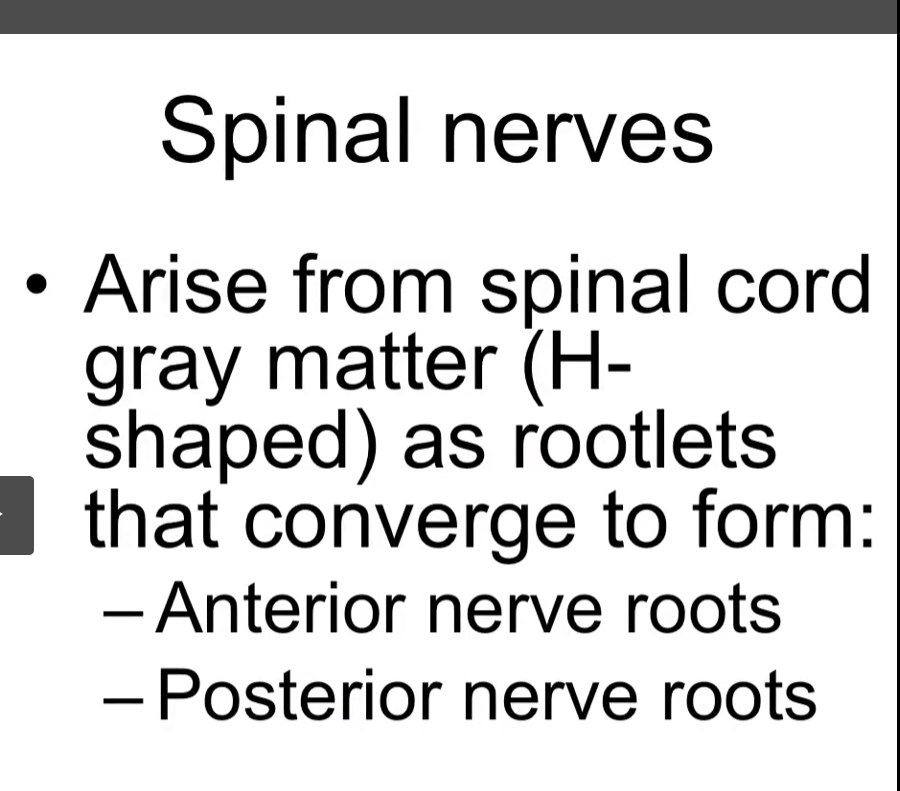
spinal nerves are formed by a combination of anterior and posterior fibers.
anterior fibers are also called motor or efferent nerve fibers.
they exit the ventral or anterior portion of the spinal cord.
whereas the posterior fibers are called sensory or afferent fibers, which end up leaving the spinal cord by the dorsal or posterior portion.
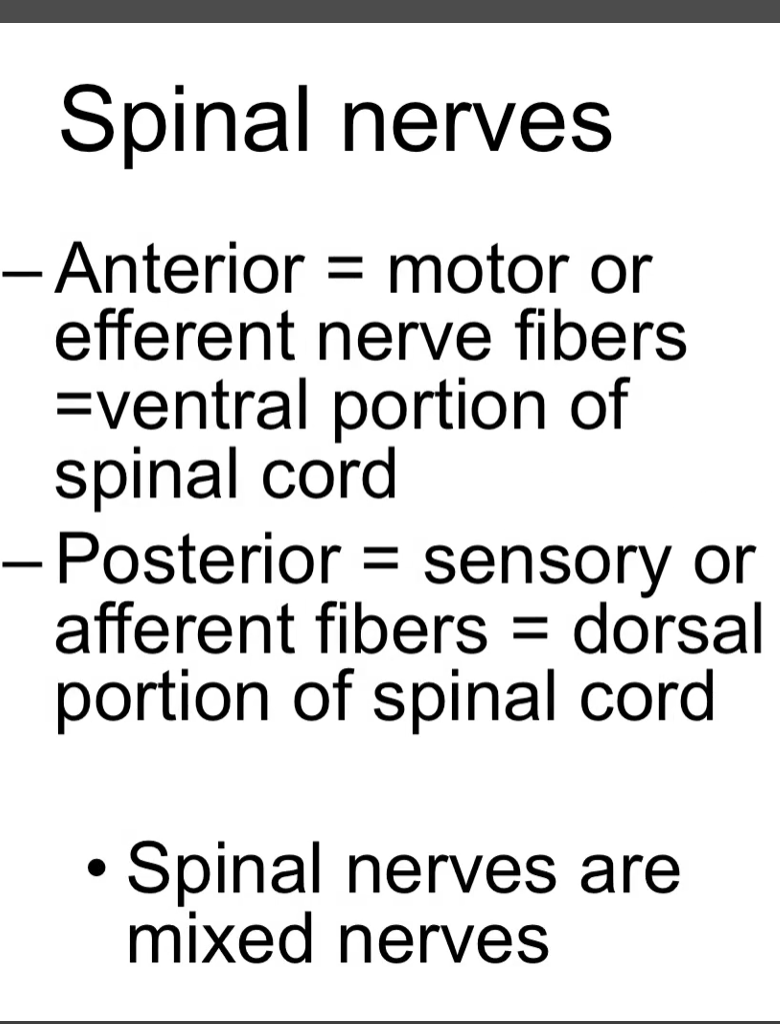
the grey matter has the H or butterfly shaped, and inside this grey matter we are able to find the neurons of the cells that reach our body.
as you can see in the image, you are able to identify the meninges that she has talked to you about. and if we take a deeper look inside the spinal cord, we are going to identify an area called the white matter and gray matter.
the grey matter of the spinal cord, has the H or butterfly shape, and inside this gray mater, we can find the neurons of the cells that are eventually going to reach our body.
the axons of the neurons are also located in the grey matter are going to exit either through the dorsal or ventral rootlets of the spinal nerves.
the anterior rootlets are going to eventually form the anterior roots as well as the posterior rootlets and posterior roots. Both roots are going to join together to form the spinal nerve. the spinal nerve splits into the posterior rami and the anterior rami.
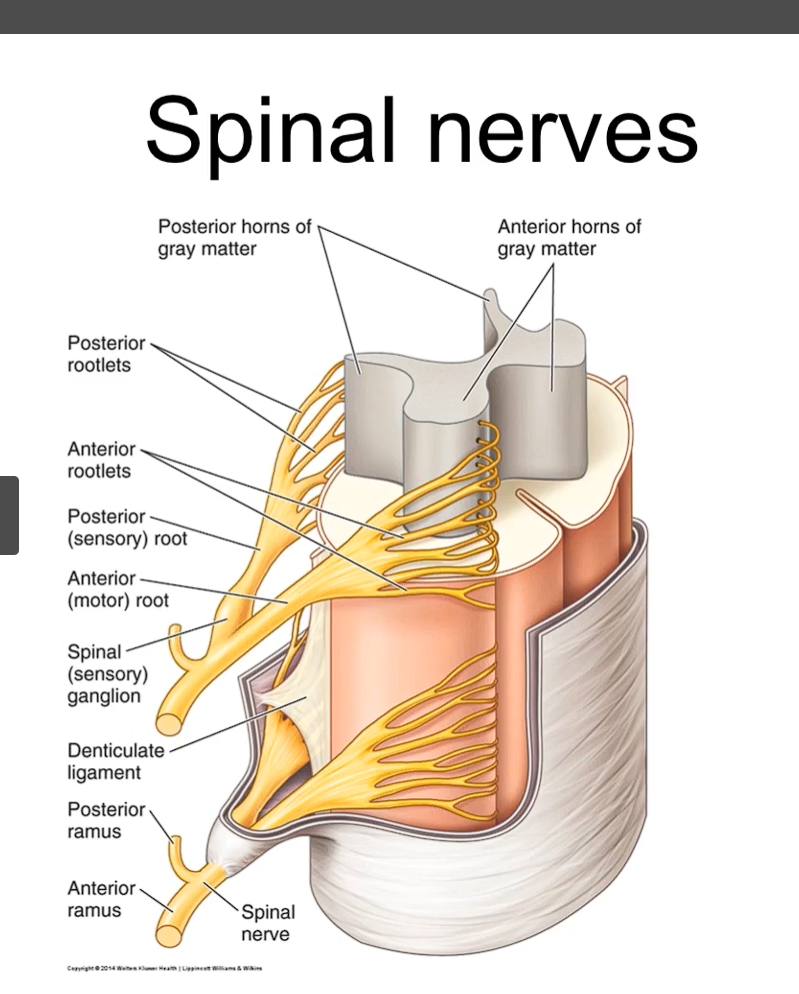
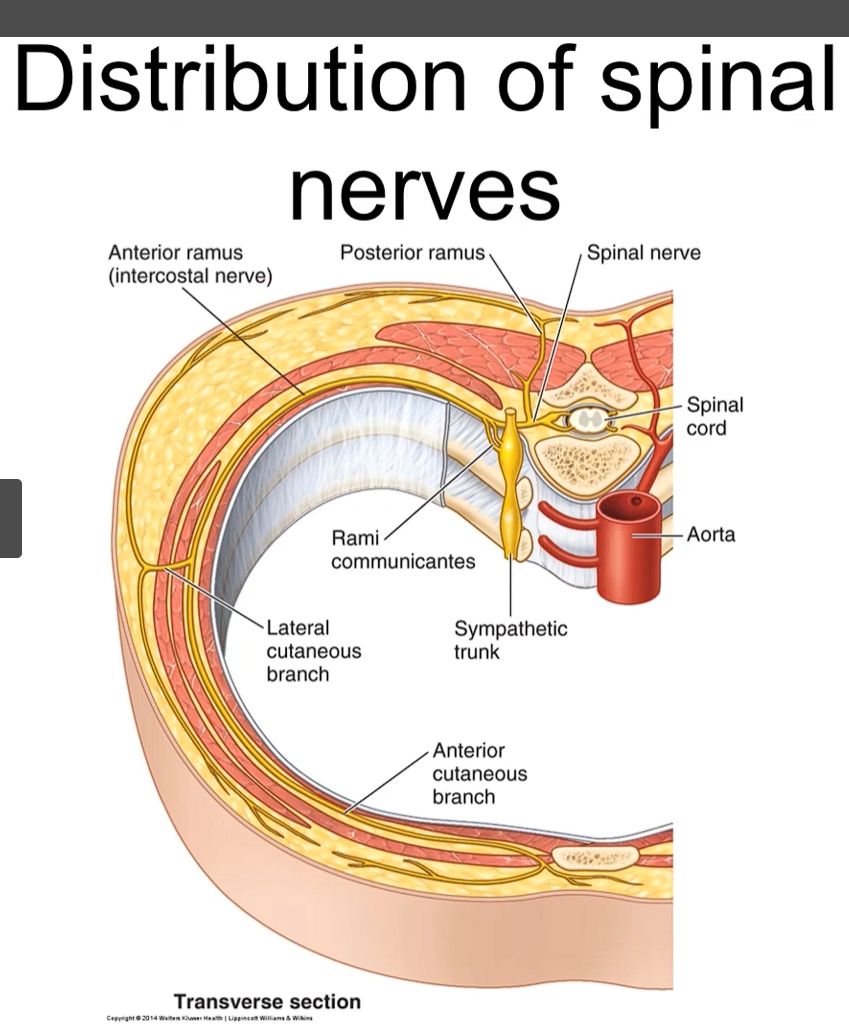
as you can see in this image, we can identify in this transverse cut of the body, that the spinal cord is inside the vertebra, specifically in the vertebral canal. the anterior and posterior roots join together to form the spinal nerve.
the spinal nerve again subdivides, and you can see here, the posterior or dorsal ramus, and you can see the different rami are going to be distributed across the skin of the back and the musculature of the back
the anterior rami on the other hand, is going to eventually reach all the anterolateral body wall as well as the rest of the structures in the body. (she literally got this from tracing the picture and looking at the slides, that’s why the PICTURE and SLIDES are important, this is ANATOMY)
once the spinal nerve is formed, it’s divided again.
posterior rami is called the primary rami.
anterior rami is greater in size and is going to reach all the other structures in the body.
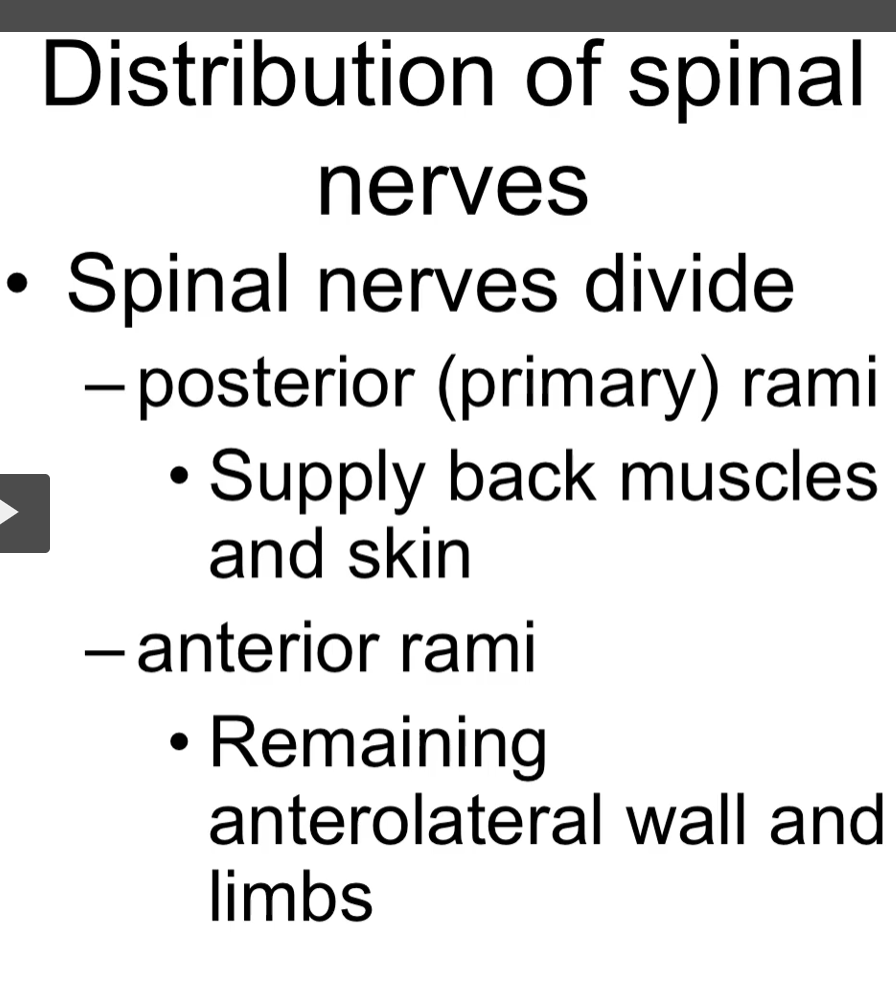
you can see the spinal nerves exit at the different levels of the spinal cord
at the thoracic level (the white area), you see a single interior rami that is going to be distributed across the different areas of the anterolateral body wall.
however, there are other areas where the spinal nerves end up mixing together with other nerves, and this area is called plexi.
plexi: areas where spinal nerves mix together with other nerves.

she just said what was on the slide.
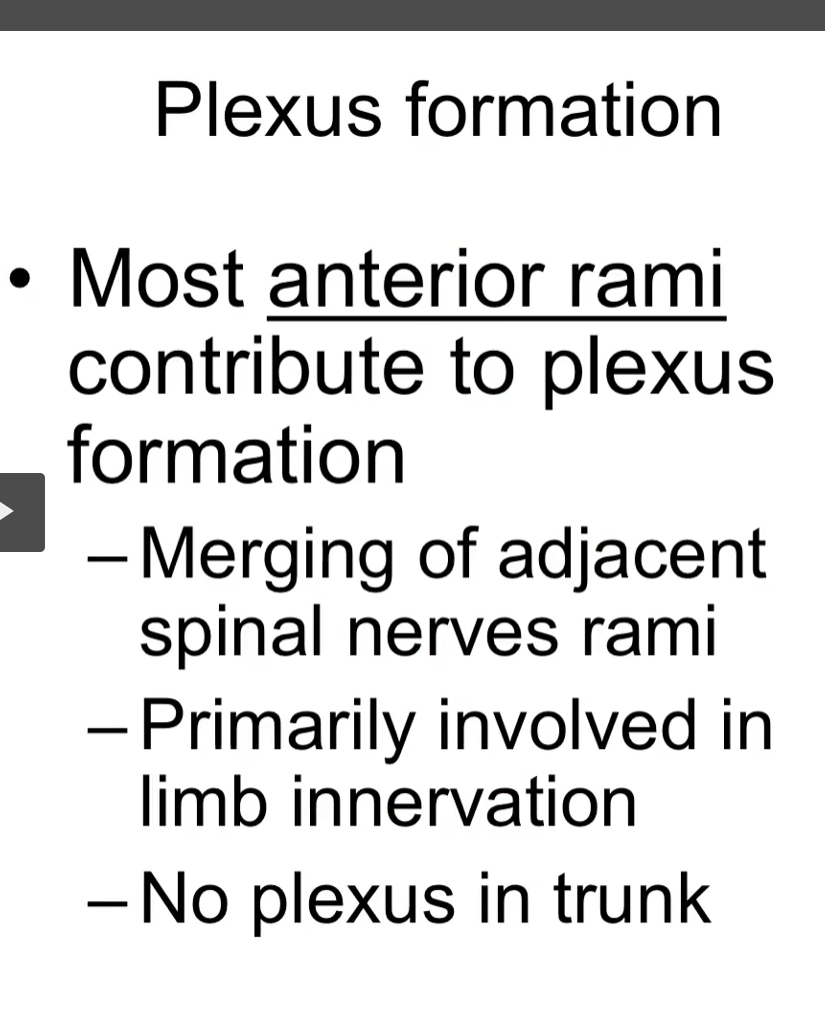
you are able to see the intercostal nerves that are the anterior rami from T1 to T12.
you can see the cervical plexus, which have different nerves that form from it.
as well as the brachial plexus which is going to be a very important part when we reach the limb portion
the lumber plexus and the sacrum plexus

the formation of plexus is very important because it leads to a new segment of multi-peripheral nerves.
as you can see here, from a cell that is specifically in the C5 region of the spinal cord, we can have the formation/contribution to various nerves.
one spinal nerve is contributing to motor fibers to many different peripheral nerves
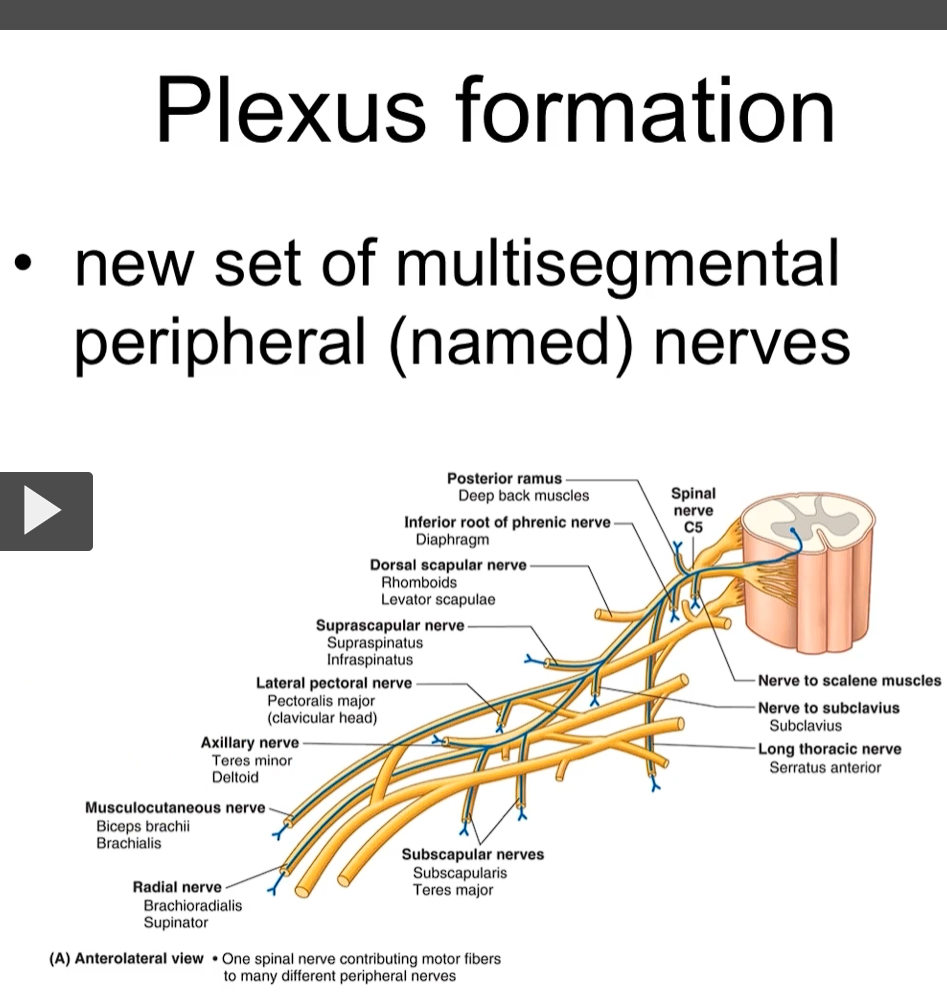
one peripheral nerve receiving sensory fibers from many different spinal nerves
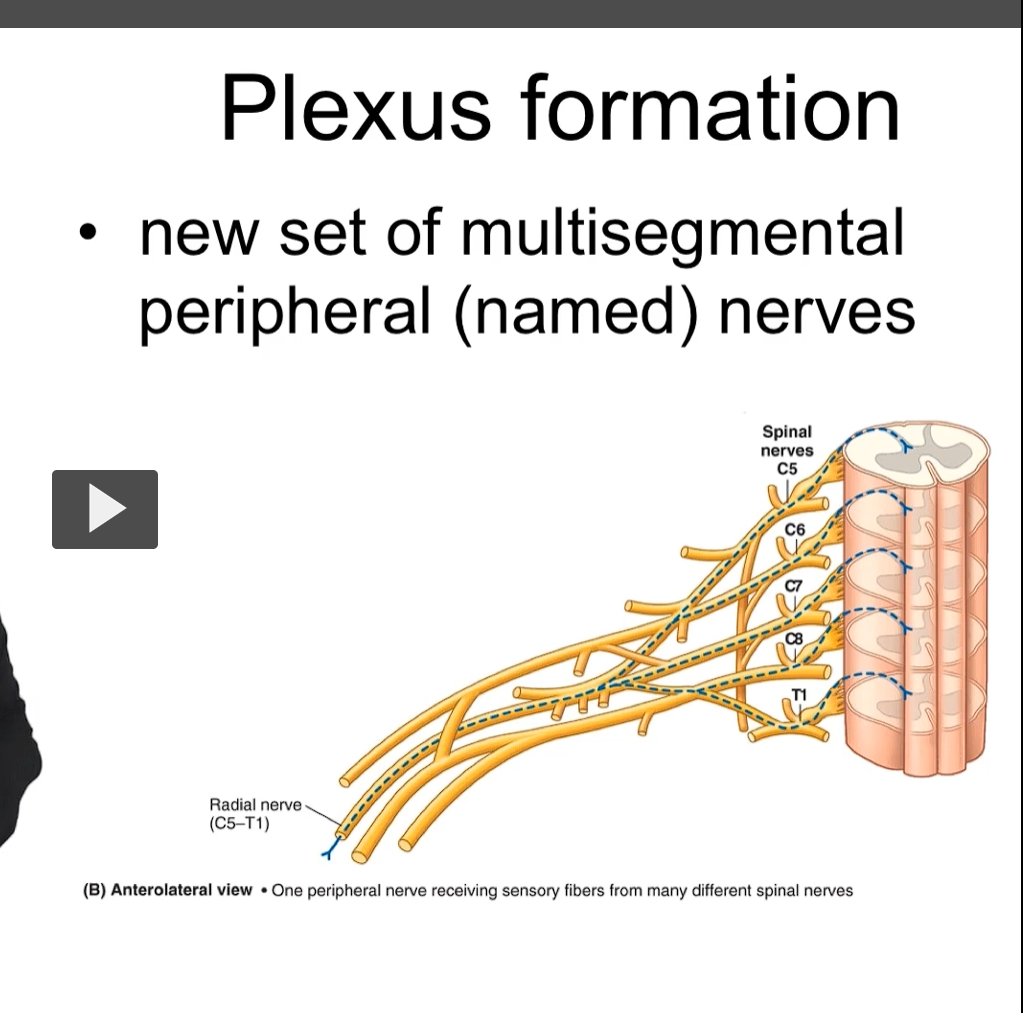
functionally the nervous system is subdivided into a somatic nervous system and a autonomic nervous system.
the somatic nervous system is mainly a motor system that hits the voluntary aeroflexive movements.
it does so by contracting the skeletal muscle
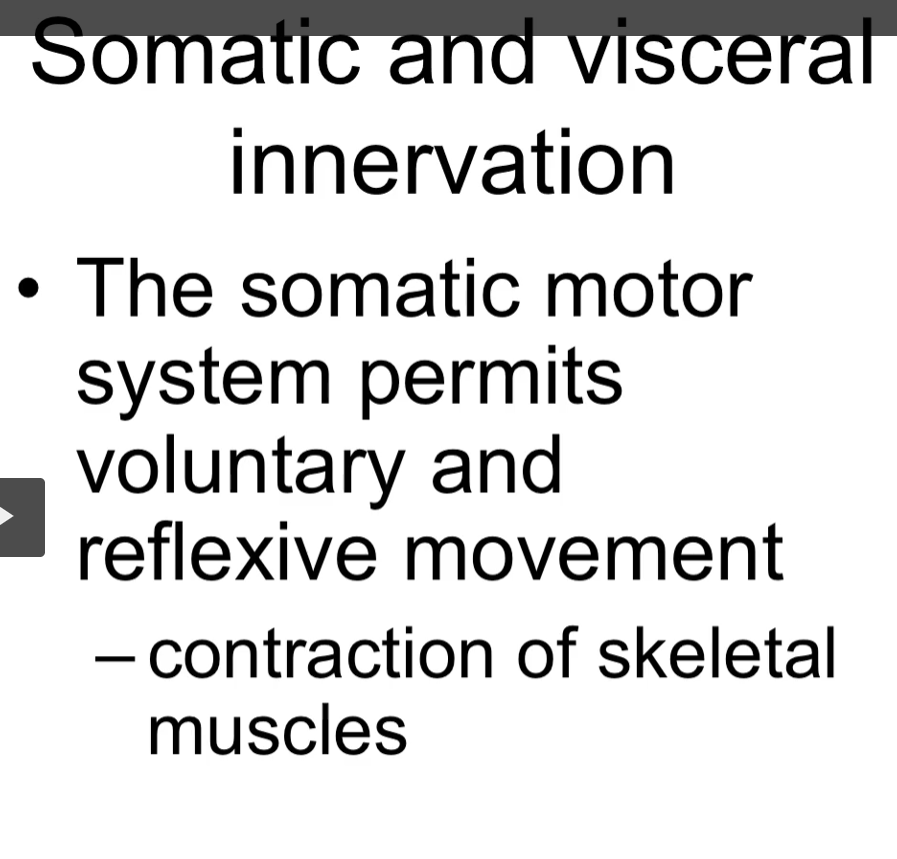
now you can think about where these fibers are entering or exiting the spinal cord.
afferent fibers are sensory fibers and efferent fibers are motor fibers.
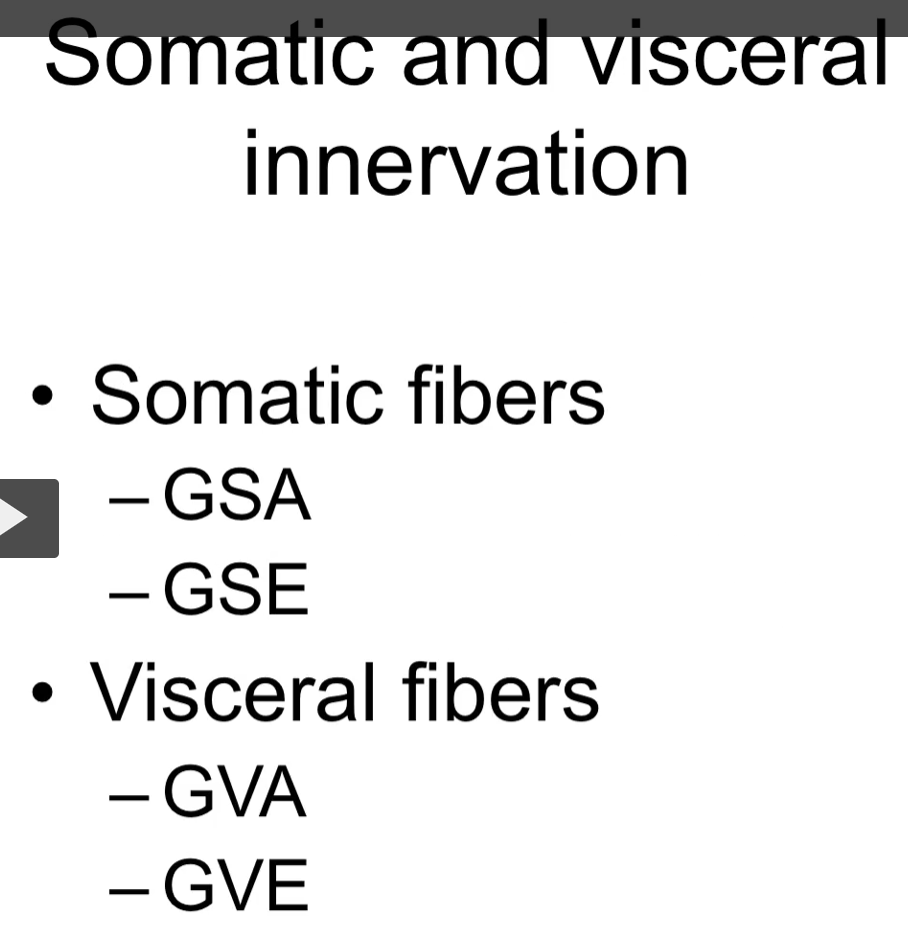
this is an example of the somatic nervous system
we touch a hot iron
sensory receptors in your skin are going to be activated
sensory receptors use the general sensory afferent fiber (GSA, pseudounipolar, the cell body of the neuron is located in the dorsal root ganglion, a ganglion is a collection of neurons outside the CNS) to the posterior or dorsal rami to
the axon of the pseudouniopolar neuron is going to enter the spinal cord via the posterior rootlets.
once the axon enters the grey matter, it’s then going to make a synapse on an interneuron.
this is gonna synapse on another neuron which is going to synapse in another neuron which is located in the anterior or ventral portion of the gray matter of the spinal cord.
this neuron that is located in the anterior portion of the spinal cord, specifically the anterior horn, is going to be called a motor neuron, this motor, or efferent neuron, is going to have an axon that exits the spinal cord via the anterior rootlets
the anterior rootlets are going to form the anterior roots and exit the spinal cord through the anterior rami.
the anterior rami is going to eventually reach the muscle that’s going to remove the hand from the source of the heat
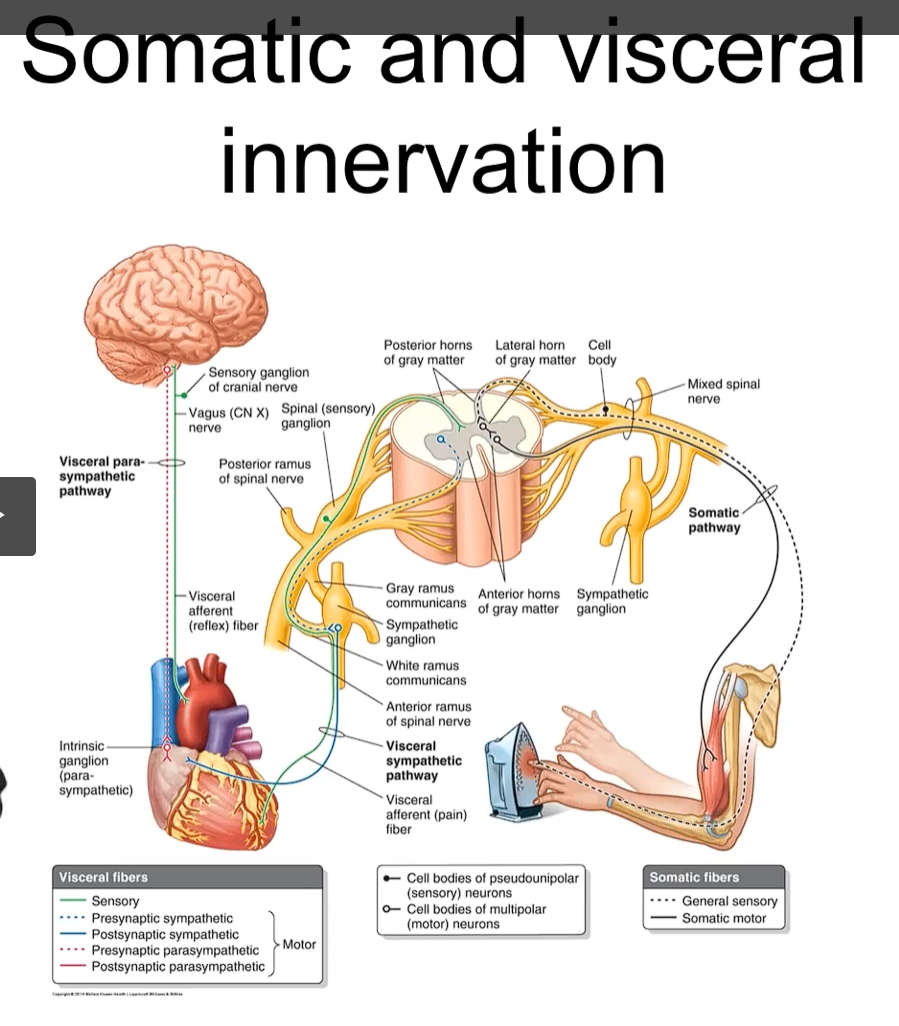
as we have seen before, we have different types of neurons in the PNS
sensory neurons received the stimuli and reach the spinal cord (CNS)
motor neurons are going to reach and target organs such as the skeletal muscle.
autonomic motor neurons is another type of cell whose main function is to control movement either in muscles that are not skeletal muscles, such as the smooth muscle and cardiac muscle. it also going to innervate glands to cause its contraction.
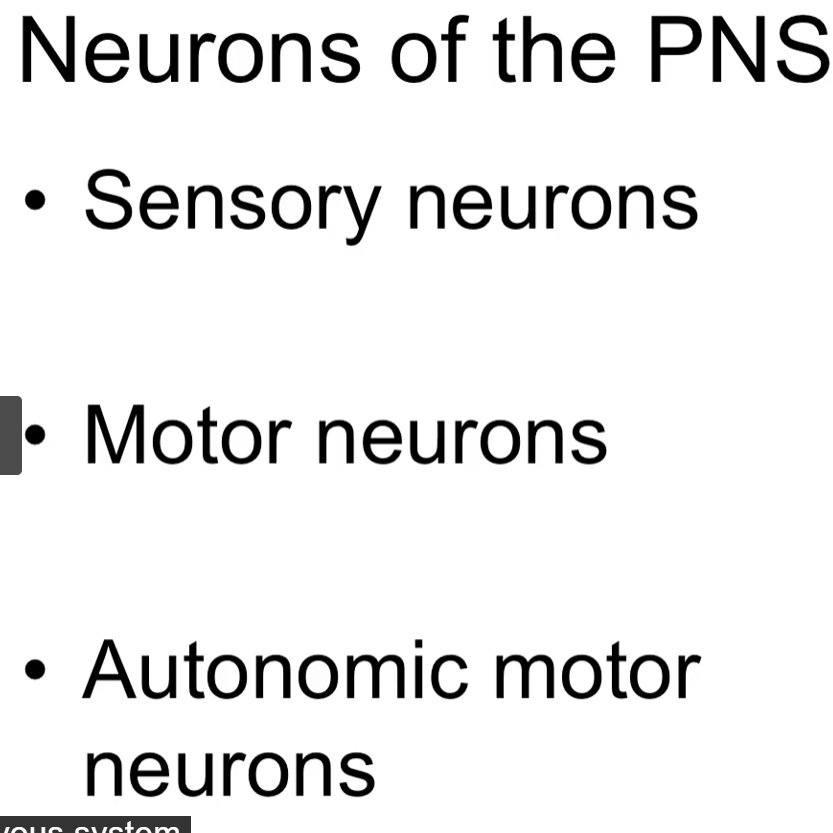
this is a picture of the different types of neurons in the PNS
a sensory neuron (pseudounipolar) has receptors, and once activated, the information is going to read the spinal cord. the cell bodies of sensory neurons are located in the dorsal root ganglia.
the motor neuron has the cell body in the anterior horn of the spinal cord, and the axon is going to exit via the anterior or ventral rootlets and roots to exit via the anterior rami to reach the effector organ (in this case the skeletal muscle)
in the case of the autonomic motor neurons, we have a set of two neurons, one that is going to exit the spinal cord via the lateral horns and exit via the anterior or ventral rootlets and anterior rami and before synapsing on the end or target organ, it’s going to synapse usually in the ganglia (this ganglion is different from the dorsal root ganglion for the sensory neurons) the ganglia is called the autonomic ganglia. now once the first autonomic neuron synapses in the autonomic ganglia, the second neuron, or what we call the postganglionic neuron, is going to reach and target these effector end organs. (gland, cardiac muscle, smooth muscle).
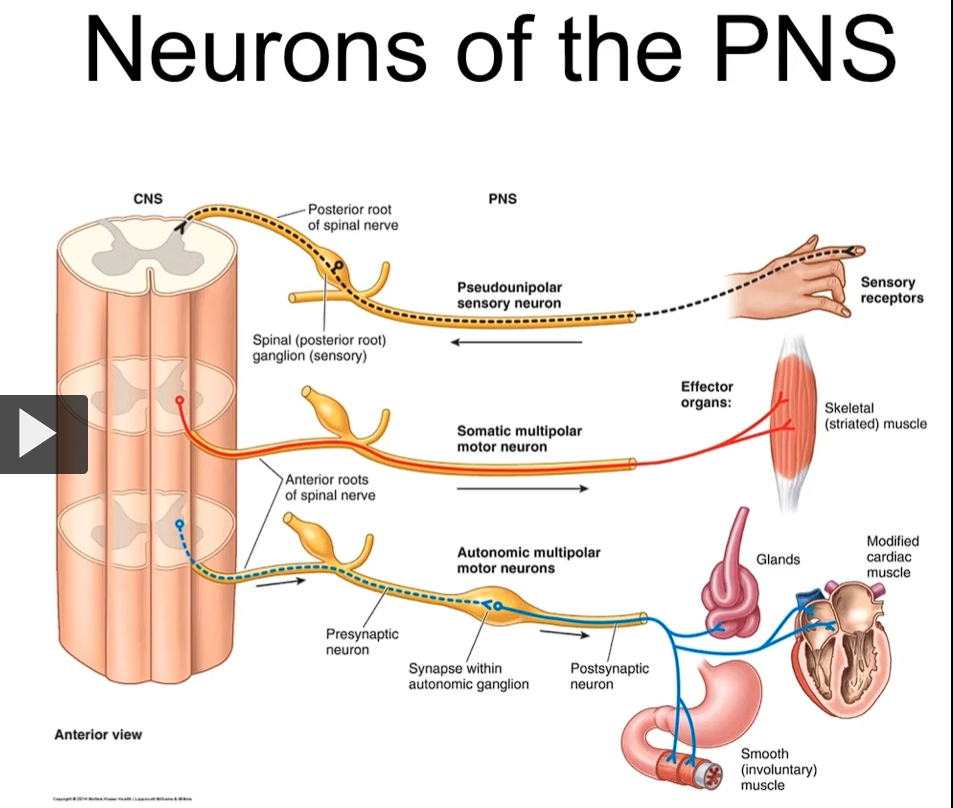
autonomic nervous system (also called visceral motor or visceral nervous system)
motor fibers that stimulate smooth muscle, cardiac muscle, and glands.
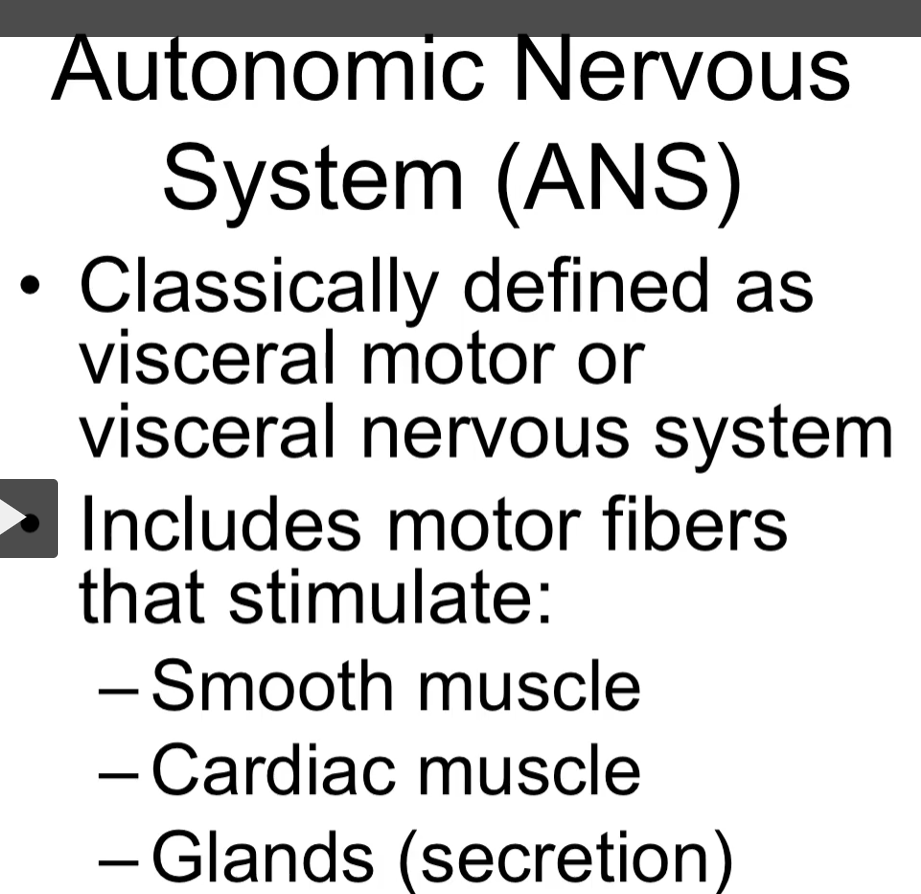
visceral efferent motor fibers in the
autonomic nervous system are also accompanied by visceral afferent fibers (sensory, pain) fibers.
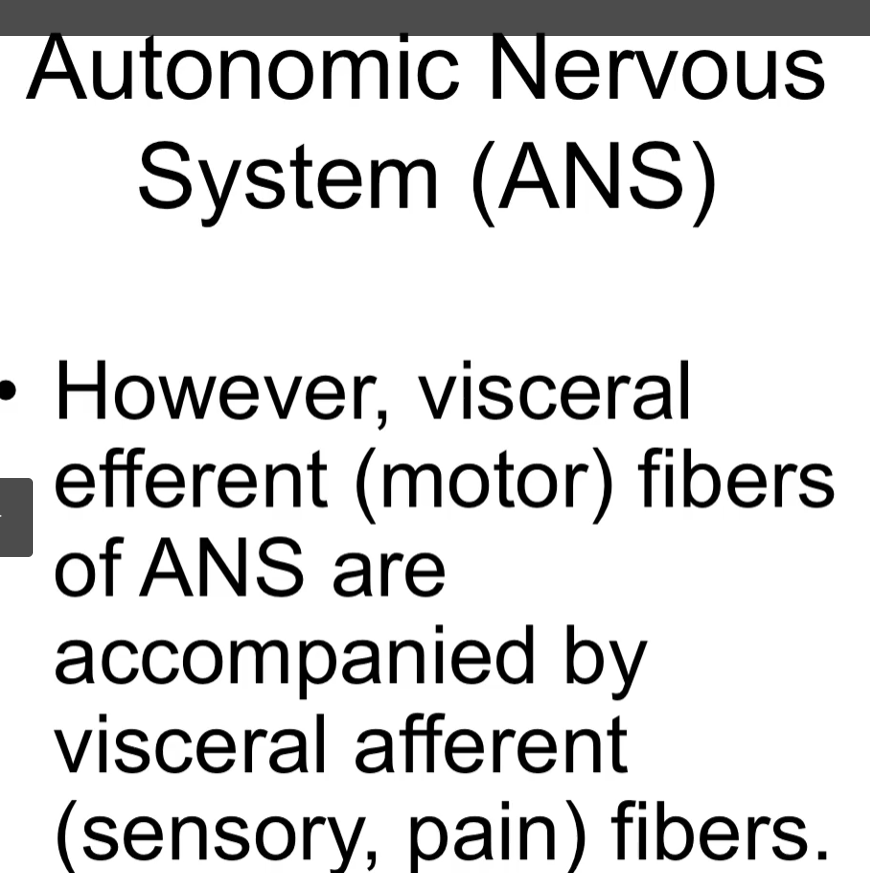
STOPPED AT 20:10